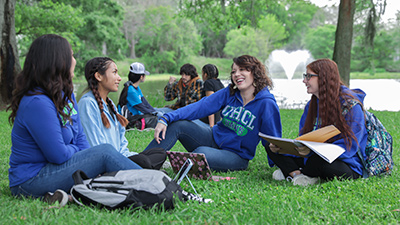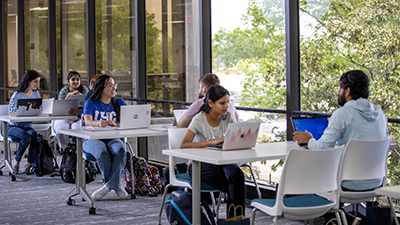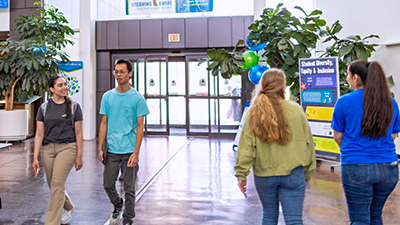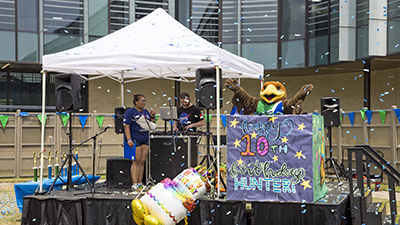
Simple Syllabus Resources
What is Simple Syllabus?
Simple Syllabus is a centralized platform designed to simplify the creation, management, and distribution of course syllabi. By offering a standardized and collaborative environment, it enables instructors to efficiently build syllabi that align with institutional policies and accreditation requirements. This platform streamlines the syllabus creation process, reduces administrative burden, and ensures consistency and compliance across departments. Additionally, it enhances student access by providing a user-friendly, digital format that makes course expectations, materials, and schedules easily accessible from any device.
What is My Role?
Faculty (Full-Time & Adjuncts)
Complete the syllabi for each course you are teaching. The following are required component areas to be edited by the faculty member:
- Instructor Information
- Attendance Policy
- Learning Outcomes
- Required Instructional Materials
- Grading Policy and Course Evaluation
- Course Topics
- Communication Policy
- Policy on Late and Make Up Work
You may add additional component areas based on the course you are teaching and the specific needs for the course, material, and/or students. The following are optional component areas that may be edited by the faculty member:
- Welcome Message
- Course Specific Instruction
- Recommended Instructional Materials
- Minimum Technology Requirements
- Table of Assignments
- Instructor Feedback to Students
- Course AI Policy
- Course Academic Honesty Policy
- Policy on Extra Credit
Approver (Department Chairs)
Approve all syllabi for courses and sections within your department (not a new process – replaces the emailing of syllabi versions). You will need to ensure that the content meets or exceeds the expectations of your department and college. You will review the items submitted by the faculty within Simple Syllabus; syllabi are no longer emailed to you or the college.
All items required and/or edited by faculty will require approval.
Required Component Areas:
- Instructor Information
- Attendance Policy
- Learning Outcomes
- Required Instructional Materials
- Grading Policy and Course Evaluation
- Course Topics
- Communication Policy
- Policy on Late and Make Up Work
Optional Component Areas:
- Welcome Message
- Course Specific Instruction
- Recommended Instructional Materials
- Minimum Technology Requirements
- Table of Assignments
- Instructor Feedback to Students
- Course AI Policy
- Course Academic Honesty Policy
- Policy on Extra Credit
* You may need to review any additional component areas that faculty add to the syllabi (will be the last items).
faculty syllabus CHECKLIST - required components
faculty syllabus CHECKLIST - optional components
Simple syllabus tipsheet
Training Resources
All UHCL Faculty have access to the complete Simple Syllabus Knowledge Base (help files and videos) using their Zendesk platform. The instructor area has information on:
- Editing your syllabi
- The Simple Syllabus Dashboard
- Instructor Experience
Learn more and create an account:
simple syllabus knowledge base
Training videos are also available through the Simple Syllabus video library, which does not require a login. Browse the videos or use the keyword search bar in the top right hand corner for topics like these, and more:
- Help with the Instructor Dashboard
- How to view, edit, and approve
- How to edit existing sections
- Trouble signing in
UHCL-specific training resources are available, including the training slide deck from the hands-on office hour sessions. Video topics include:
- Finding Simple Syllabus Template
- Navigating in Simple Syllabus
- Replacing Component Content
VIEW UHCL TRAINING resources
*For issues accessing UHCL Training Videos, contact Pam Shefman at Shefman@uhcl.edu.
Upcoming Simple Syllabus Office Hours
For assistance with Simple Syllabus, attend one of the upcoming hands-on sessions.
General Sessions - All Welcome
(Faculty, Adjuncts, Approvers)
In-Person
November 5, 2025
3-4 p.m.
SSCB 2201.03
November 7, 2025
10-11 a.m.
SSCB 2201.12
December 1, 2025
3-4 p.m.
SSCB 2201.03
December 3, 2025
10-11 a.m.
SSCB 2201.03
January 5, 2026
9-10 a.m.; 3-4 p.m.
SSCB 2201.03
January 6, 2026
3-4 p.m.
SSCB 2201.03
Approver Sessions
(Department Chairs Only)
In-Person
December 5, 2025
10-11 a.m.
SSCB 2201.12
January 8, 2026
2-3 p.m.
SSCB 2201.03
Upcoming Deadlines
January 6, 2026, by 5 p.m.
Deadline for Faculty to Submit Spring '26 Syllabi
January 9, 2026, by 5 p.m.
Deadline for Department Chairs to Approve Syllabi
January 10, 2026
Canvas and Syllabi Available to Students
*Winter Mini Term Deadlines TBA*
Frequently Asked Questions
Is using Simple Syllabus required for faculty and adjuncts?
Yes, Simple Syllabus is the tool that has the official UHCL syllabi for all courses. In the event of a student grievance, the approved syllabus in the Simple Syllabus tool on Canvas will be the only syllabus used. Therefore, faculty are required to use Simple Syllabus.
Can I opt out of Simple Syllabus in Canvas?
No, see above FAQ on requirement to use Simple Syllabus.
How do I access Simple Syllabus?
Simple Syllabus is directly connected to each course via the Canvas shell. Once a shell is produced for the course, you can start working on the syllabus. You can also use the SSO (go.uhcl.edu) to find Simple Syllabus.
Before August 4th (while summer 2025 classes are in session), the Simple Syllabus tool is hidden from the Canvas navigation. Please use these instructions if you cannot find Simple Syllabus.
What do I do if the tile for my course in Canvas is missing?
OIT recommends users first use the university's online course schedule search system to determine (1) whether the course exists in the schedule, and if so (2) whether their name is shown as the instructor. If both conditions are true, they should contact OIT's Support Center to have a ticket created so that the IDT team can investigate why the Canvas course tile isn’t showing for them. Other most likely reasons for this are (1) there may be too many courses for all to display on their Dashboard (for which IDT will provide instructions to the user to clean up the Dashboard to display their latest courses) or (2) the automated processes that add instructors to their Canvas shells are scheduled to pick up and add their enrollment on the next data run.
My syllabus order is different from Fall 2025 to Spring 2026, is that expected?
Yes, the UHCL template is slightly different because of faculty feedback. The main UHCL template cannot be reordered.
Editing Items in Simple Syllabus
What is a Simple Syllabus "component"?
Components are the building blocks for the syllabus tool that create sections within the syllabus. Components can be pre-populated with information from the information system, Canvas, or a template. Components can be required or optional. Faculty can create new sections in their syllabus to fit their course and content.
What is a "public" component?
When editing, you can make non-required components Public or Private. Public means that anyone who sees the final, published syllabus can see this component. Anyone can see the UHCL library (without credentials) at uhcl.simplesyllabus.com. Public also makes a component visible to those at UHCL and can be copied from one semester to the next within your own library or the UHCL library. Private items cannot be copied, even by the instructor who created it.
What is a "visible" component?
When editing, you can make non-required components visible or invisible. Visible means that students can see the published version of the component. If it is invisible, no one can see the component.
What do I do if I cannot see the editing tools for components when using Simple Syllabus in my Canvas shell?
You might want to clear cookies for the site as a first step. Also, you can always use the SSO (go.uhcl.edu) to work on your syllabi outside of Canvas. If that does change what you see, it is possible that an adjustment to the display scaling in your browser to 100% could work. If that does not make a difference (or it is already 100%), check for Accessibility or High Contrast Settings look for high contrast themes, magnification tools, and/or accessibility settings (like large fonts or screen readers) then disable them temporarily to see if the layout changes. After any of these steps, you might need to clear the site data.
How do I copy a syllabus? I have multiple sections or similar content that I don’t want to do more than one time.
There are two options for adding content to any syllabus. You can import components using the “import” function on the side bar and any public UHCL content can be selected. After you select and import those items, it will replace it in your tool for review before submission. The second option is to use the “replace with a different syllabus?” link at the top of the syllabus you are editing. This option allows you to choose from your own library. Note that Simple Syllabus does recognize courses with the same rubric and number as the same in your own library and will automatically import the components for you from a submitted syllabus when opened for editing. Syllabi can be edited and modified before submission regardless of the method used.
Can I move Simple Syllabus components? If I add components, where do they go?
Simple Syllabus provides a set UHCL template and components cannot be moved within the template. When you add components, each one is added at the bottom in the order added. You cannot move any component, even your added components, therefore, the order added components are placed does matter.
How do I save my work in Simple Syllabus?
Simple Syllabus auto-saves your work. If you leave Simple Syllabus open or leave the workspace your work will be saved for you. If you are working on a component area that requires a manual “save” you will see a save button.
Merged/Cross-listed Courses in Canvas
What do I do with cross-listed or mirrored courses?
Instructors must complete a syllabus for each course that they are assigned as an
instructor, regardless of how Canvas is built out to teach the course. An instructor
can only complete one syllabus, even if there are multiple sections connected, within
the Canvas shell. The Canvas completed syllabus is the one of the parent course within
Canvas. An instructor will need to complete the separate syllabus/syllabi for the
other course(s), and they do so within their Simple Syllabus dashboard (logging in
from the SSO at go.uhcl.edu).
Simple Syllabus receives every individual section directly from the schedule with
PeopleSoft data, and a syllabus is created for every section, and each section will
be in the instructor “to do” list in the SSO for Simple Syllabus until submitted for
approval.
To use the already created parent course syllabus to replace the not yet complete syllabus, use the "Replace with a different syllabus?" option that is above the syllabus header and select the completed syllabus. Additionally, if content is wanted from a different instructor, one can import components to copy the public content for these courses from the selected course and then can update components as needed. For more details see “How do I copy a syllabus?” from above.
If I have merged my classes in Canvas, what syllabus do students see?
The parent course shell in Canvas is the one connected to Simple Syllabus for Canvas for the instructor. All students, regardless of the parent Canvas shell, see the syllabus for the course that they are enrolled in. In example, XXXX3301.01 (student A is enrolled here) is merged with XXXX3301.02 (student B is enrolled here) in Canvas. XXXX3301.01 is the Canvas parent course. The instructor must create both syllabi (XXXX3301.01 & XXXX3301.02). If they only edit, publish and get approval for XXXX3301.01, student B will not see a finished syllabus. Students and faculty can go to the Simple Syllabus dashboard (via go.uhcl.edu) and there the syllabus they see is the syllabus based on the course enrollment or have a role as instructor.
How does the table of assignments work and do I need to use it? How does it work in a merged or cross listed course?
The use of Table of Assignments is optional. You can make it invisible and not use it. This component is tied to the Canvas shell. Only one section/course is connected to the shell therefore it works well if you do not have a merged or cross listed course in Canvas. You have 2 options for completing the non-Canvas shell syllabus for a merged class that does not have the table (note: it will not get a table because it does not have a Canvas shell to read from). Options 1: You can take a clip from the original/parent shell and add it to the second/child course in the Topic and Assignment component via the dashboard (go.uhcl.edu). Option 2:You can also use the link that you have for the original/parent syllabus (you can get the URL from that syllabus from the dashboard or on the top right part of the syllabus) and place that in the second/child syllabus.
Viewing Course Syllabi
In "student view" I cannot see all the syllabus components, why is that?
First, the “student view” in Canvas is not connected to a student enrolled in the class so anything that you put as “private” would be not visible to you in Canvas using the student view. To view items in the syllabus that are private you must have a role that has enrollment in the course. Students can see the private components, but faculty cannot as the canvas student role.
Where is my syllabus viewed? Who can see my syllabus?
There is a public library that once published (typically on census) anyone can view
components that are Public in any syllabi. There are no credentials needed to see
public syllabi. When using UHCL credentials (LMS or SSO), those enrolled or teaching
the course(s) can see those syllabi that they are enrolled in or have a role (aka
instructor) for. What they see is based on the course and section that they are enrolled
in or have a role for. When enrolled, you can see both public and private content
from the components.
NOTE: Students see the syllabus based on their enrollment in the course. They can
see the version of the syllabus for the course they are enrolled in through the LMS
(aka Canvas) shell or using the Simple Syllabus library. This is important for cross-listed
or merged courses.
What if my students say they cannot see all the items in our course syllabus?
There are several places where students can see the syllabi and not be logged in a way that could verify their enrollment status. If the student uses the schedule tool or the simple syllabus dashboard (without logging in), they will see only the public syllabus. Any items that faculty make private in the syllabus, students might not see what they need to. If they are looking as a logged in user in Canvas and the private items are not showing that is an issue needs to be addressed using the simple syllabus help desk (see the question on students accessing simple syllabus help).
Can students access Simple Syllabus Help?
Yes, there are a couple ways that they can submit tickets. If a student is looking
at their dashboard in Simple Syllabus under the "my courses page" there will be a
question mark at the bottom left which they can click and it will bring up a support
ticket for them to fill out. Another way is when they are directly accessing their
syllabus in Canvas, there will be a question mark they can click on as well.
Using the Optional Table of Assignment Component
How does the table of assignments work and do I need to use it? How does it work in a merged or cross listed course?
The use of Table of Assignments is optional. You can make it invisible and not use it. This component is tied to the Canvas shell. Only one section/course is connected to the shell therefore it works well if you do not have a merged or cross listed course in Canvas. You have 2 options for completing the non-Canvas shell syllabus for a merged class that does not have the table (note: it will not get a table because it does not have a Canvas shell to read from). Options 1: You can take a clip from the original/parent shell and add it to the second/child course in the Topic and Assignment component via the dashboard (go.uhcl.edu). Option 2:You can also use the link that you have for the original/parent syllabus (you can get the URL from that syllabus from the dashboard or on the top right part of the syllabus) and place that in the second/child syllabus.
Can I edit the Table of Assignments in Simple Syllabus?
The "Table of Assignments" section automatically displays assignments pulled from the course's Canvas Assignments. If unedited, this table will actively update as changes are made in Canvas without any intervention from the faculty or approvers. Faculty can edit this table, however, it will no longer be connected to Canvas Assignments and then changes will not be automated. Faculty can "revert" this component, any edits that need to be recreated will be needed, and an approval process will be initiated.
What content does Simple Syllabus use from Canvas?
Simple Syllabus does not pull the content from Canvas over (like Modules, etc.). The "Table of Assignments" section automatically displays assignments pulled from the course's Canvas Assignments. It provides students with an overview of graded work and due dates for the course.
For more details and specific information from Simple Syllabus review this article: https://simplesyllabus.zendesk.com/hc/en-us/articles/38055681522317-Troubleshooting-Schedule-Component-Integrations
If I made changes to the Canvas assignments do I need to change the syllabus? Will I need re-approval?
The use of Table of Assignments is optional. You can make it invisible and not use it. If you are using it, any changes you make to the Canvas assignments will update the syllabus table cells as you do them (e.g. due dates, etc.) and do not require re-submission or approvals. Only published assignments will show. Once you publish assignments they will appear, and you do not need to re-submit or get re-approved for those changes. If you have merged/cross listed courses, these changes will not update the second/child syllabus as it is not connected to Canvas. However, the syllabus in Canvas that all students see will be updated and available in Canvas.
Required Materials and Textbooks
How are textbooks being added to my syllabus?
Textbook information is being added daily based on the Follett adoption for the courses. If your data is fine, you do not need to make any changes. You can edit and add your own textbook and override any imported information if it is incorrect. Duplication may occur due to CTAP and different information that is not visible on the component for coding. You can remove duplicates. Once you have modified this component, it will not change (even if the imported file changes). You will not need to re-submit the syllabus regardless of any delays in the imported data. If the imported data is changed and you did not edit this component, you will not need to make any changes after approval of the new content to appear in the syllabus. Integration changes will not affect your syllabus after approval.
What do I do if the required instructional material (or the required textbook) is missing in my course(s)?
The required instructional material data is populated from the Follett database based on adopted materials and CTAP. If the materials section is missing or inaccurate, check with the Follett interface to ensure that the expected material(s) is listed there. There is a possibility that the data needs to be refreshed, and it may occur overnight. For 2025-2026, this field is editable and can be updated to reflect the approved materials.
Approval Process
Who approves my syllabus and why?
Department chairs approve syllabi to ensure compliance with university requirements. According to the section on responsibilities of department chairs and under course coordination and scheduling, "Review, approve, and monitor textbook selections, course syllabi, office hours, and other course-related items to ensure compliance with university requirements." Chairs who are teaching in the semester will also have to approve the syllabus/syllabi for their courses.
What triggers an approval to my syllabus and why?
Department chairs approve syllabi as mentioned under the "who approves" FAQ. Submitting a completed syllabus triggers an approval process. Any edits to previously approved component sections require re-approval. Approvers are notified of the component that was edited in the re-approval message, therefore, it is known where to review for approval.
If my syllabus was not approved, where can I see what is needed?
When syllabi are not approved, the chair is required to enter a comment. That comment should be emailed to the instructor with the notification that it was not approved. If you cannot find that email or the comment, the syllabus history has the comment saved. To get to history, scroll to the end of the syllabus and click 'Show Full History'. When you click Show Full History, a scrollable history will appear, and you can see the comments in this pop-up area.
If I made changes to the Canvas assignments do I need to change the syllabus? Will I need re-approval?
The use of Table of Assignments is optional. You can make it invisible and not use it. If you are using it, any changes you make to the Canvas assignments will update the syllabus table cells as you do them (e.g. due dates, etc.) and do not require re-submission or approvals. Only published assignments will show. Once you publish assignments they will appear, and you do not need to re-submit or get re-approved for those changes. If you have merged/cross listed courses, these changes will not update the second/child syllabus as it is not connected to Canvas. However, the syllabus in Canvas that all students see will be updated and available in Canvas.
Additional Support
For additional support with Simple Syllabus:
- Email your question to help@simplesyllabus.com
- Place a support ticket through Simple Guide
- Attend virtual office hours through Simple Guide
- Use the in-site help form (access by clicking the question mark icon in the lower left corner when logged into your Simple Syllabus site)
For UHCL-specific questions, contact your Department Chair.






